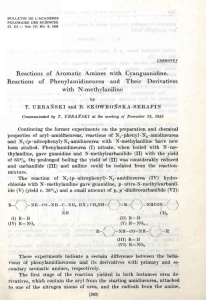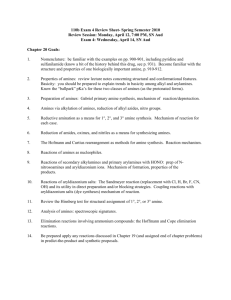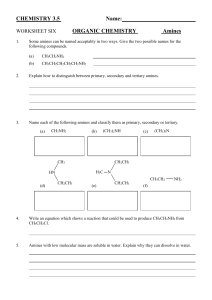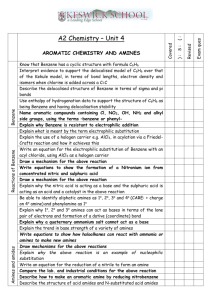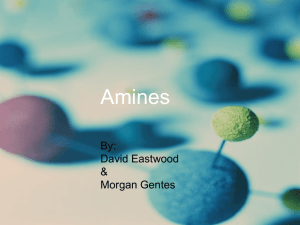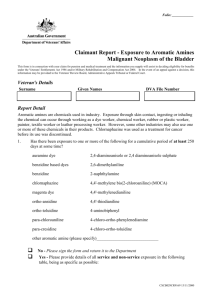Amines
advertisement
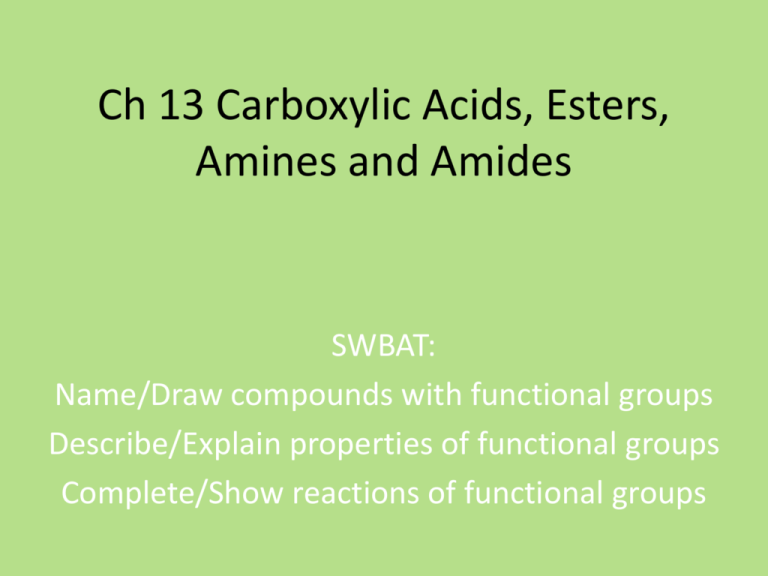
Ch 13 Carboxylic Acids, Esters, Amines and Amides SWBAT: Name/Draw compounds with functional groups Describe/Explain properties of functional groups Complete/Show reactions of functional groups Chapter 13.4 Amines Amines • They are derivatives of ammonia NH3 • H-groups are replaced by alkyl or aromatic groups Subclasses of Amines Naming Amines • • • • Similar to ether… List the alkyl groups in alpha order No gaps Ends in -amine methylamine dimethylamine Practice ethylmethylpropylamine ethyldimethylamine triphenylamine Aromatic Amines • Aromatic amines use the name aniline • Amino bearing Carbon is C#1 aniline 2,6-diethyl-4-methylaniline Naming Anilines •Alkyl groups attached to the nitrogen of the aniline are named with the prefix Nfollowed by the alkyl name N-ethylaniline N, N-dimethylaniline Properties of Amines Boiling Point • Amines can have polar N-H bond, so they can form H-bonds • But…N is not as electronegative as the O in alcohols…so the H-bonds are weaker! • BP is below Alcohol Bp differences among different types of amines! • 1o amines highest BP (2 H-bonds) • 2o amine lower (1 H-bond) • 3o amine lowest (only dipole) Properties of Amines Solubility • Amine group is polar: soluble in water, will form H-bonds • Small amines (1-5 C atoms) are soluble • Large amines (<6 C atoms) are not Famous Amines • Acetyl choline – neurotransmitter • Nicotine Famous Amines • Prozac – Fluoxetine • Caffeine Reaction of Amines A. 1o and 2o Amines react as Bases – they accept H+ ions like ammonia below: The unpaired valence e- of N attract H+ H+ H-N-H + H2O → H-N-H + OHH H NH3 + H2O → NH4+ + OHammonia ammonium ion Reacting as a Base • Primary • Secondary Dimethylamine dimethyammonium ion • Tertiary amines do not react! Neutralization Reaction Base + Acid → Salt NH3 + HCl → NH4+ClAmmonia Ammonium chloride (salt) a) Primary amine CH3-NH2 + HCl → CH3-NH3+ClMethylamine methylammonium chloride b) Similar for secondary amine Homework Chapter 13 Page 448 13.34 – 13.44 (even)
